STIAS fellow Anne Pitcher, Professor of Political Science and African Studies at the University of Michigan, provided a detailed study of a confidential report on housing provision that was based on a visit to Singapore by Kenyan bureaucrats in 1971. She highlighted the exchange between Singapore and Nairobi as an early example of policy emulation and sharing in the global South.

“The literature on South-South policy emulation and sharing between Asian and African countries has expanded tremendously in the last decades,” she said. “However, consistent with the emergence of the term ‘Global South’ much of that literature is grounded in the present. This work seeks to locate the historical origins of relationships among southern countries by examining the efforts of Kenyan bureaucrats to emulate Singapore’s housing policy just after independence. Embarking on six-day trip in 1971 to study how Singapore had solved its housing deficit, civil servants from the ministries of housing, health, finance, land and other branches of the Kenyan government hoped to apply lessons from Singapore to address Nairobi’s intractable housing shortage.”
She also stated that the sensibilities expressed by bureaucrats in the report “challenge contemporary understandings of African bureaucrats as self-serving. The report promotes ideas of bureaucratic efficiency, cosmopolitanism and housing delivery as a condition of citizenship. Inspired by Singapore’s housing success, the report advocates state-driven solutions to the housing problem in Nairobi and relates housing to human dignity.”
Besides contributing to the debate on the features of South-South exchanges and bureaucrats as ’discursive subjects’, Pitcher also aims to respond to geographer Jennifer Robinson’s call to urban scholars to engage in greater “formal comparative reflection” in order to internationalise urban theory.
“I argue that stressing the histoire croisée or ‘crossed history’ of Singapore and Kenya offers a more suitable theoretical approach to understanding the transfer of knowledge and the policy networks among the two countries than a strict comparison,” she said.
Similarities and differences
The two countries had a shared experience of British colonialism and ethnic diversity as well as the substantial challenge of rapid urbanisation and resulting housing shortages.
“During colonialism, Nairobi was growing, but there was deliberate underspending by the colonial government on urban housing to discourage Africans from settling in the cities”. After independence, efforts to address the housing crisis were not very effective. As Pitcher stated: “There was an explosive growth in informal settlements particularly in Nairobi. As one example, the Mathare Valley settlement population increased from 3000 in 1965 to 60 000 by 1971 without the corresponding provision of housing, water, electricity and sanitation. This was a population of importance to the government – as they were well organised politically and loyal government supporters.”
“People in informal settlements were also not living for free on the land,” she continued. “Many companies bought land, built houses and rented them out, often taking advantage of inhabitants by charging high rents.”
“The Kenyan government was not poor at this stage and there was also huge pressure to build houses for civil servants,” she added.
“By the late 1960s President Kenyatta declared that housing required urgent attention. The archives are full of reports, articles and letters discussing housing.”
The Kenyan government latched on to Singapore as a model for successful housing provision and this initiated the trip and report. Key features of Singapore’s success included an independent housing and development board, land accrual by the state and a comprehensive long-term policy of industrialisation combined with housing in the form of high-density, high-rise flats.
But, as Pitcher pointed out, the two countries did not have a lot in common and were not necessarily good candidates for comparison. “Singapore is centralised while Kenya is decentralised and covers a much larger area. Kenya had a much lower GDP of $152 per capita versus Singapore’s $427 per capita. The Singapore population was only 2 million while Kenya’s was 10 million and the Singapore population was more educated. Although a strict comparison might be inappropriate, the relationship was still valuable.”
“I think it’s about the value of the exchange – the ‘crossed history’ – even if it was not possible to directly copy the Singapore success, the experience had meaning for the Kenyans. It reinforced for them the power of the state and of bureaucratic interventions as well as the importance of stability and belonging.”
“It also shows us that cross-national learning in the global South predates the contemporary,” she added. “And the contact has continued between the two countries.”
“Also the fact that the report presents the bureaucrats as modern, cosmopolitan, ‘discursive subjects’ moves us from the tropes of the venal, self-interested, African civil servant common in the political science literature.”
In this regard Pitcher pointed to four thematic areas that the bureaucrats used to frame what they had seen. These included an articulation of modernist ideals – faith in progress and the remaking of the environment; the belief in the role of the state as a driver of urban development; the value of professional development, learning, expertise and training; and, the enunciation of utopian politics with the distribution of housing linked to political stability and involved citizenship.
In discussion, Pitcher outlined some of the subsequent developments within Kenya.
“There was some progress in housing development – many schemes were launched but provision remained slow and complicated, and eventually couldn’t keep up with demand,” she said. “The Kenyan government later switched to site-and-service schemes and more DIY applications. But the problem remains – President Kenyatta’s Big 4 Agenda still calls for the provision of a half million houses by 2022.”
“Kenya is seen today as one of the archetypal corrupt states,” she continued. “I think it’s good therefore to unpack and present moments of selflessness dedicated to the realisation of a dream. Housing problems are presented as a new thing but there is a long history of problems with many of the same challenges as today – the problems existed before the advent of neoliberalism.”
Michelle Galloway: Part-time media officer at STIAS
Photograph: Christoff Pauw
